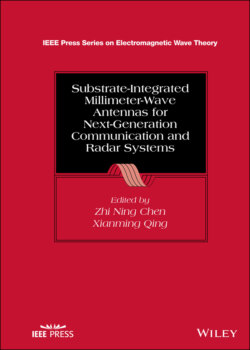Читать книгу Substrate-Integrated Millimeter-Wave Antennas for Next-Generation Communication and Radar Systems - Группа авторов - Страница 24
1.5 Briefing of State‐of‐the‐Art Millimeter Wave Antennas
ОглавлениеFrom an antenna operation point of view, mmW antennas can be any type of radiators, such as wire, aperture, slot, microstrip, reflector, and Lens as shown in Figures 1.2, 1.3, and 1.4. Also the radiators can be arranged as arrays to enhance their radiating performance and achieve more functionalities. However, due to the unique challenges caused by their physically short wavelengths, namely 1 mm at 300 GHz to 10 mm at 30 GHz in free space as mentioned above, some types of radiators are more suitable for mmW antenna designs, as shown in the general discussion listed in Table 1.4. The discussion is based on the basic versions of all types of antenna designs. A variety of variations of the antenna have long been proposed for performance enhancement as presented in the References [21, 22].
Table 1.4 mmW antennas.
| Type of radiator | Fabrication/Testing | Performance/Applications | Sketches |
|---|---|---|---|
| Aperture:HornOpen‐end waveguideWaveguide horn | Easy fabrication and testBulky three‐dimensional geometry for metal structuresDifficult to be integrated with circuitsLow loss for air‐filled designPossibly fabricated using PCBa and LTCCb processes | Moderate bandwidthHigh gainPoint to point linkStandard antennas in measurement systems | Figure 1.2 |
| Microstrip patch | Easy fabrication and testFlat and low‐profile geometryLossy at high frequenciesWide feeding stripsConformal configurationEasy to form arraysEasy to be integrated with circuitsEasy to be fabricated using PCB and LTCC processes | Narrow bandwidthLow gainBroadside radiationWide applications | |
| Slot:On groundOn cavityOn waveguide | Easy fabrication and testFlat geometryEasy to form arraysConformal geometryDifficult to be integrated with circuits | Narrow bandwidthLow gainBroadside radiation | Figure 1.3 |
| Reflector:CornerFlat planeCurved plane | Not easy fabrication and testBulky and three‐dimensional geometry with feedNot easy to form arraysDifficult to be integrated with circuits | Wide bandwidthUltra‐high gainDirectional radiation | Figure 1.4 |
| Lens:LuneburgConvex‐planeConcave‐planeConcave‐concaveConvex‐concaveConvex‐concaveConvex‐convex | Not easy fabrication but easy testBulky, heavy and three‐dimensional geometry with feedNot easy to form arraysDifficult to be integrated with circuits | Wide bandwidthUltra‐high gainDirectional radiation | |
| Wires and their variations on substrate | Easy fabrication and testFlat and low‐profile geometryLossy at high frequenciesWide feeding stripsConformal configurationEasy to form arraysEasy to be integrated with circuitsEasy to be fabricated using PCB and LTCC processes | Moderate bandwidthLow gainBroadside/endfire radiation |
a PCB: printed circuit board.
b LTCC: low‐temperature co‐fired ceramic.
Also the antennas can be categorized into two classes based on physical geometry: flat/planar and three‐dimensional structures. For high‐gain applications, which are always required for mmW systems as mentioned previously, three‐dimensional designs such as reflector and lens antennas are perfect options if there is no space and installation constraints; the large‐scale arrays of planar elements such as microstrip antenna arrays and slot antenna arrays usually suffer from the difficulty to form the large‐scale feeding network in a limited physical space and high loss caused in the feeding networks.
As an alternative, a technique of laminated waveguides on PCB substrate was invented [23, 24], which is to some degree considered the extension of the work based on post‐rod to form air‐waveguides [25]. Later the structure was comprehensively studied and named as substrate integrated waveguide (SIW) and widely applied in mmW antenna designs [26, 27], where an electromagnetic waveguiding structure is constructed by the two walls formed by two arrays of metalized vias. The spacing between the adjacent vias must meet the criteria to stop the leak of wave propagating in the structure. Such a substrate‐integration technology provides much flexibility for waveguide designs and relevant antenna designs, in particular, at mmW bands.
